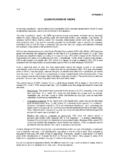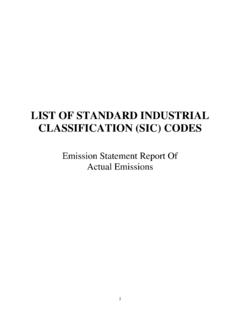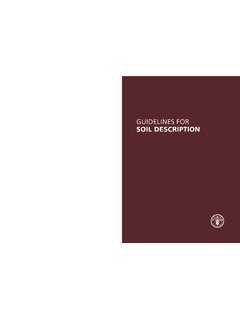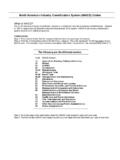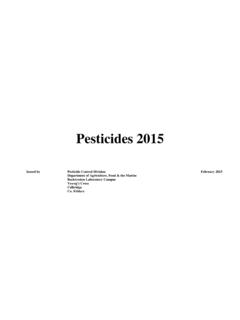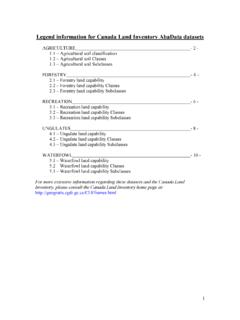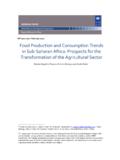Transcription of Reduction Agriculture for Poverty Economic …
1 Please cite this paper as:Cervantes-Godoy, D. and J. Dewbre (2010), EconomicImportance of Agriculture for Poverty Reduction , OECDFood, Agriculture and Fisheries Working Papers, No. 23,OECD : food , Agriculture and FisheriesWorking Papers No. 23 Economic importance ofAgriculture for PovertyReductionDalila Cervantes-Godoy*, Joe DewbreJEL Classification: I32, O10, O13, O40, O57, Q10,Q18*OECD, France 1 Acknowledgments This paper reports findings from analysis done for the project The Economic importance of Agriculture for sustainable development and Poverty Reduction financed by a grant from the Government of the Netherlands as part of the 2009-2010 Program of Work of the Committee for Agriculture (COAG). Earlier versions of the paper were discussed at meetings of the Working Party of the COAG on Agricultural Policies and Markets (APM). The authors wish to thank the Ministry of Agriculture of the Government of the Netherlands for the financial support, and are grateful for the many helpful comments received on earlier versions of the paper provided both by Member Country Delegations to the APM meetings and by numerous OECD colleagues.
2 Abstract The Millennium Declaration set 2015 as the target date for halving the number of people living in extreme Poverty . Exceptional progress in some developing countries makes achieving that goal globally a realistic possibility. However, many countries will fall far short, and up to 1 billion people are likely to remain destitute by the target date. Why are some countries doing better than others? This paper seeks to answer this question by looking for shared characteristics of twenty-five developing countries posting extraordinary success in reducing extreme Poverty over the past twenty to twenty-five years. These countries were compared using indicators of their macroeconomic characteristics and, especially, their agricultural Economic characteristics. The countries chosen for analysis constitute a highly diverse mix. The group includes some of the poorest and some of the richest developing countries in the world, representing virtually all geographic regions.
3 The countries also differ greatly in their systems of governance and Economic management. Yet, they are surprisingly similar in their achievements, not only in reducing Poverty , but across the broad range of macroeconomic and agricultural Economic performance measures used to compare them. Findings from time-series, cross-section regression analysis reveal that while Economic growth generally was an important contributor to Poverty Reduction , the sector mix of growth mattered substantially, with growth in agricultural incomes being especially important. Keywords: Poverty Reduction , Agricultural Development, Millennium Development Goals. 2 TABLE OF CONTENTS Economic importance OF Agriculture FOR Poverty Reduction .. 3 Introduction .. 3 Literature review .. 4 Measuring Poverty and success in reducing it .. 6 Selection process .. 8 General characteristics of selected countries .. 9 How important was agricultural growth?.. 12 Characteristics of countries where Agriculture contributed positively to Poverty Reduction .
4 16 Agricultural trade policy .. 17 Agricultural research .. 18 Agricultural productivity and Poverty .. 19 Expenditures on 20 Conclusions .. 21 ANNEX .. 23 REFERENCES .. 25 Tables Table 1. Selected countries and Poverty outcomes, 1980-2005 .. 9 Table 2. Human Development Index, selected countries .. 10 Table 3. Selected countries macroeconomic indicators .. 11 Table 4. Selected countries: key indicators, 1980-2005 .. 13 Table 5. Major contributor to Poverty Reduction .. 16 Table 6. Evolution of Agricultural Nominal Rate of Assistance .. 17 Table 7. Evolution of agricultural expenditure .. 21 Table Regression results .. 24 Table Multicollinearity test .. 24 Figures Figure 1. Poverty and agricultural GDP per worker, (25 selected countries) .. 14 Figure 2. Poverty and non-agricultural GDP per worker, (25 selected countries) .. 14 Figure 3. Poverty and remittances per capita, (25 selected countries) .. 15 Figure 4. Total average contribution to Poverty Reduction .. 16 Figure 5.
5 Growth in public expenditures in R&D, 1981-2005 (average, year ranges vary) .. 18 Figure 6. Average annual growth in agricultural Total Factor Productivity (TFP), 1991-2006 .. 20 3 Economic importance OF Agriculture FOR Poverty Reduction Introduction Theodore Schultz began his acceptance speech for the 1979 Nobel Prize in Economics observing: Most of the people in the world are poor, so if we knew the economics of being poor we would know much of the economics that really matters. Most of the world's poor people earn their living from Agriculture , so if we knew the economics of Agriculture we would know much of the economics of being poor (Shultz, 1979). Thirty years on we still find that people in developing countries who depend on Agriculture for their living are typically much poorer than people who work in other sectors of the economy and that they represent a significant share, often the majority, of the total number of poor people in the countries where they live.
6 Achieving the Millennium Development Goal (MDG) of halving Poverty by 2015 requires finding ways to increase the incomes of those people. What can government do to foster that kind of income growth? Specifically, how can we improve development co-operation, trade and agricultural policy to better promote Agriculture s contribution to Poverty Reduction ? This paper constitutes the first output from a research project seeking answers to that question. Globally, the percentage rate of Poverty (though not in all countries the total number of poor people) has declined steadily during the past thirty years, an achievement credited largely to Economic growth (World Bank, 2008a). But what causes Economic growth and, more relevant for present purposes, what causes agricultural growth? There is widespread agreement on a general list of necessary conditions, : access to output and input markets accommodated by a good transportation, marketing and processing infrastructure; non-discriminatory tax and trade policy; high rates of investment in agricultural research and extension; a system of ownership rights that encourages initiative; employment creating non-agricultural growth; well functioning institutions; good governance and so on.
7 However, debate abounds on their relative importance and what government ought to do to promote them. The approach we adopted in seeking to better inform such debate was to look for shared characteristics of developing countries posting exceptional success in reducing extreme Poverty over the past twenty to twenty-five years. Inspired by the World Bank s 2008 Growth Report (Commission on Growth and Development), our method is based on the premise that a limited number of pre-conditions are necessary everywhere, if not always sufficient, for sustained progress in reducing Poverty . The Growth Report examined common features of thirteen countries that since 1950 grew their economies at an average annual rate of 7% or more for 25 years or longer. In like fashion, we chose a list of twenty-five countries that in recent years achieved reductions in national Poverty rates at a pace that might enable them to reach their respective MDG s of halving Poverty by the 2015 target year.
8 We start by looking at some indicators of economy-wide Economic performance but then give particular emphasis to common features of the agricultural economies of the selected countries. We make no attempt to establish causality or to quantify the relationships between the various indicators and Poverty . We aimed simply to see if those countries chosen on the basis of their exceptional success in reducing Poverty were similar in other socioeconomic respects. The insights obtained from this multi- 4 country overview are meant to inform the design of in-depth case studies of Agriculture s contribution to Poverty Reduction in four countries (Ethiopia, Ghana, Indonesia and Vietnam) wherein we may seek to quantify Poverty impacts through econometric or simulation analysis. It is hoped that findings from the case studies will eventually provide the basis for development of policy principles and recommendations to foster progress in reducing Poverty .
9 Literature review Historically, few issues have attracted the attention of economists as has the role of Agriculture in Economic development and Poverty Reduction , generating an enormous literature of both theoretical and empirical studies. Much of this literature focuses on the process of structural transformation of economies, from the least developed in which Economic activity is based largely on Agriculture , to high-income countries where industry and services sectors dominate. A declining share for Agriculture in national employment and GDP is an inevitable consequence of Economic progress (Byerlee, de Janvry and Sadoulet, 2009; Timmer, 1988; Cervantes and Brooks, 2009). This is largely due to higher income elasticities of demand for non-agricultural goods and services. As their incomes grow, consumers increase their consumption of manufactured goods and services faster than their consumption of food . Paradoxically, the process is usually accompanied by rising incomes and a lower incidence of Poverty among those who depend on Agriculture for a living.
10 Lewis (1955) was one of the first of many development economists attempting to explain the paradox. He viewed Economic development as a process of relocating factors of production from an agricultural sector characterized by low productivity and the use of traditional technology to a modern industrial sector with higher productivity. Lewis s theory was interpreted as advocating industrialization and used to justify government policies that favoured protection for domestic industries and, explicitly or implicitly, taxed the agricultural sector (Kirkpatrick and Barrientos, 2004). That theory and it implications for policy have been largely debunked by later work and the degree to which Economic policies of developing countries discriminate against Agriculture has lessened dramatically in recent decades (Anderson and Valenzuela, 2008). A paper produced by DFID (2004) emphasises the historically close correlation between different rates of Poverty Reduction over the past 40 years and differences in agricultural performance particularly the rate of growth of agricultural productivity.










